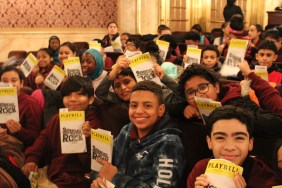Afropunk recently posted two back-to-back art posts that, on first reading (superficial reading), could not have been more different in terms of content – the art and artists being surveyed – and the social, cultural and political meanings of the works. The first piece was “Young, Black and Victorian: A History in Photographs.” The second was “Moving Towards Abstraction: Digital Artist Manzel Bowman.”
But just as a carefully curated art exhibition sparks new ways of seeing and thinking about the art, with smart juxtaposition being the catalyst for a rewiring of the eyes, the proximity of the two posts forces the reader/viewer to go beyond conventional thought and appraisal of what they are ingesting.
The presentation of the black Victorian photos is the disinterring of black images (black lives, aesthetics, dreams, possibilities) that have been lost to history, bringing them to the here-and-now to flesh out the past and hopefully illume the future. The work of Manzel Bowman is about imagining black agency and possibility beyond a mere seat at the table (the big seat at the White House; the CEO seat at some Fortune 500 company). It’s about artfully transcending the external and internal limitations imposed on visions we might engender for ourselves.

In tandem, the posts and their contents converse, engage each other. They feed and feed off one another, exploding preconceived notions of and received wisdom about blackness. They bring to mind the Afrofuturism and Afrosurrealism movements and the ways practitioners and disciples remix past, present, and future to get at something beyond the status quo, to divine something beyond material or corporeal blackness while absolutely being rooted in love and defense of blackness.
It’s rooted in work by Octavia Butler, Sun Ra, George Clinton, and William Gibson, in the presences of Uhura on Star Trek and Lando Calrissian in Star Wars, in the aural innovations of hip-hop and jazz and techno, in films like Space is the Place and the music videos and persona aesthetics of Janelle Monae. That’s all just for starters.
Chardine Taylor-Stone:
“Afrofuturism also goes beyond spaceships, androids and aliens, and encompasses African mythology and cosmology with an aim to connect those from across the Black Diaspora to their forgotten African ancestry.”
Michael A. Gonzales:
“The term Afrofuturism has become a cultural catchphrase to describe the world of tomorrow today in music, art, theater, politics and academics. Yet depending on whom you talk too, the definition of Afrofuturism often differs from person to person.”
D. Scott Miller:
“Afro-Surrealism is about the present. There is no need for tomorrow’s-tongue speculation about the future. Concentration camps, bombed-out cities, famines, and enforced sterilization have already happened. To the Afro-Surrealist, the Tasers are here. The Four Horsemen rode through too long ago to recall. What is the future? The future has been around so long it is now the past.”

More on Afrofuturism here and here. More on Afrosurrealism here.
Ernest Hardy is a Sundance Fellow whose music and film criticism have appeared in the New YorkTimes, the Village Voice, Vibe, Rolling Stone, LA Times, and LA Weekly. His collection of criticism, Blood Beats Vol. 1: Demos, Remixes and Extended Versions (2006) was a recipient of the 2007 PEN / Beyond Margins Award.




